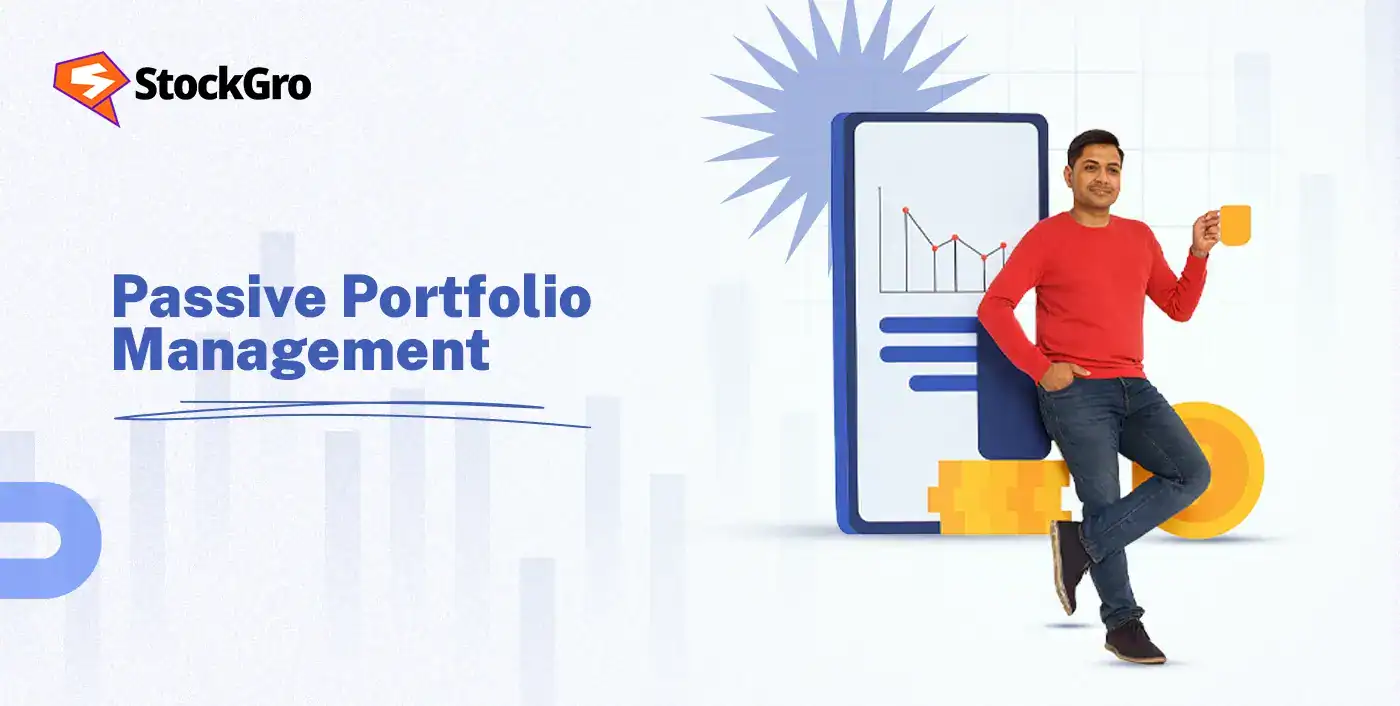
In October 2025, Motilal Oswal Mutual Fund (MOMF) released its third edition of Passive Survey 2025, which states that about 68% of the investors will invest in at least one passive fund in their portfolio in 2025, up from 61% in 2023. The findings show that passive funds are becoming mainstream in India.
With this growing interest in passive funds, understanding passive portfolio management is a type of portfolio management which helps investors see how index investing builds long-term wealth through diversification, lower costs, and tax efficiency.
Read this blog further to know about passive portfolio management, the benefits of passive investing, and passive vs active portfolio management for a deeper understanding.
What Is Passive Portfolio Management?
To begin with, what is a passive fund? A passive fund is a fund designed to replicate the performance of a market index, such as the Nifty 50. For example, an index fund such as SBI Nifty Index Fund, or an ETF.
Passive portfolio management is an investment strategy that aims to manage a passive fund in a way that replicates the performance of a market index. This is achieved by creating a portfolio with the same securities in the same proportions as the index, which requires minimal buying and selling, resulting in lower costs and less activity monitoring.
How It Works: Index Tracking & Buy-and-Hold
Passive portfolio management involves simply buying and selling securities to align the portfolio with the index, which results in lower transaction costs and short-term capital gains tax compared to active management.
It requires minimal research and management, so the fees for passive funds are much lower, allowing investors’ capital to grow through compounding.
Index Tracking:
This strategy is designed to replicate the composition and performance of a selected market index.
- Passive funds: Index funds hold the same stocks in the same proportions as their chosen benchmark index, and ETFs are similar to index funds and track an index or benchmark and are traded on an exchange.
- How it works: A passive fund either uses full replication, that is, holding all assets in the index, or sampling, that is, holding a representative portion of the assets, to achieve returns similar to the benchmark. The difference that may occur in performance is known as ‘tracking error’.
Buy-and-hold:
This is a long-term investment philosophy where an investor purchases a security and holds it for years or decades, regardless of short-term market downturns.
- Leverage compounding: Investing for the long term generates returns that create wealth over time.
- Minimises costs: It avoids the trading costs, commissions, and short-term tax implications of frequent buying and selling.
- Ignore market timing: Investors avoid market fluctuations, considering only historical trends, and believe the market tends to rise in the long run. This prevents emotional or impulsive decision-making.
Benefits of Passive Portfolio Management
Passive portfolio management is a low-cost investment strategy that provides a wider view of the market and minimises taxable capital gains due to low trading turnover.
Low Fees & Cost Efficiency
Passive funds have lower expense ratios compared to active funds because fund managers are simply tracking an index, which doesn’t require excessive analysis and trading. And, since there is very little buying and selling, investors save money on transaction fees.
Diversification & Consistency
Since passive funds track an index, these portfolios invest in a wide range of assets by default, which helps to minimise risk. The portfolio mirrors the benchmark index as closely as possible, which provides a consistent return in the long run.
Tax Efficiency & Minimal Turnover
The low turnover strategy implemented by passive fund managers reduces the realisation of short-term capital gains that are taxed at a higher rate compared to long-term capital gains. The emphasis on holding assets for the long term qualifies for long-term capital gains.
Limitations to Consider
- Limited Scope for Higher Returns: A Passive portfolio mirrors a market index, which means it can only match the market’s performance, not beat it. Hence, the investors lose the chance of earning higher returns or taking advantage of undervalued securities.
- Market Declines Affect the Entire Portfolio: As passive funds invest in every stock within an index, they move along with the market. So if the market index falls, it falls too.
- No Room for Tactical Adjustments: A passive portfolio follows fixed rules, leaving almost zero scope for any action during changing market conditions. Index updates happen infrequently, so underperforming stocks may stay in the fund longer than is ideal.
Passive vs Active: What’s the Difference?
| Features | Passive portfolio management | Active portfolio management |
| Aims to? | It aims to mirror its index fund. | It aims to beat its index fund, and generate alpha returns. |
| Approach | It undertakes very few trading activities, and matches performance to the benchmark. | It undertakes frequent trades based on excessive research and analysis. |
| Costs incurred | It incurs lower cost and involves lower expenses ratio. | It incurs higher fees and costs due to active management and activities. |
| Risks applicable | It attracts lower risks compared to active funds, but is subject to market risks, with very little risk adjustment. | It undertakes higher risks as it reacts to short-term market fluctuation and has potential of underperformance. |
| Suitability | It is suitable for investors seeking alpha returns, and are comfortable with higher risk and higher fees. | It is suitable for investors seeking steady, market-based growth, with a preference for lower costs and a hands-off approach. |
Real-World Popularity & Growth
The rising preference for index investing is reshaping India’s mutual fund landscape. To understand this better, here’s a look at the latest data from Stoxo on passive fund management.


This result shows how passive investing is taking hold in India. Now, more investors own index funds, driven by their lower costs and simplicity, and even distributors are increasing their use of passive products. With this steady growth and wider awareness, index investing is turning from an alternative approach into a regular part of investor portfolios.
How to Implement a Passive Portfolio
Here are some steps an investor can take to implement a passive portfolio:
- Define your investment goals: Investors should first determine their financial goals and evaluate their comfort level with market volatility.
- Build the passive portfolio: Next, the investors can carefully select low-cost index funds or ETFs that track major market benchmarks and spread investments across equity, debt, and gold funds to reduce risk.
- Automate and maintain investments: Investors can set up SIPs for regular investing, stay focused on long-term goals, and review the portfolio annually to realign with target allocation.
Conclusion
Passive portfolio management has proven that wealth needs direction and not constant movement. Through passive investment, investors can capture long-term growth with lower costs, diversification, and minimal effort.
As more investors are recognising the benefits of passive investing, it’s clear that simplicity often wins the race. Passive portfolio management isn’t just about chasing performance but staying invested by keeping costs low and letting compounding do the lifting over time.
FAQ‘s
The main goal of passive portfolio management is to match the returns of a chosen market index rather than beating it. It focuses on consistency, diversification, and cost and tax efficiency.
Passive investing tracks a benchmark index with minimal trading, while active investing involves frequent trading and research to outperform it. The passive investment is steadier and more cost-effective compared to active investment.
Passive funds involve less trading activity and research, which keeps management fees and transaction costs lower compared to actively managed funds.
Yes, but they are usually ideal for investors who prefer long-term, steady growth with minimal involvement and lower costs, rather than frequent trading or chasing short-term returns.
In the case of passive portfolios, a simple annual review is enough, and rebalancing once a year helps to maintain the desired asset allocation without any unnecessary trading.
Tracking error refers to the small lags or deviations between a fund’s returns and the index it follows, often caused by expenses, cash holdings, or delays in rebalancing.
Yes, Stoxo helps investors to analyse fund performance, track index movements, and monitor portfolio alignment, which can make passive investing more informed and efficient.

